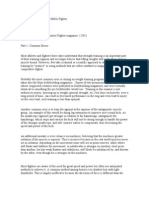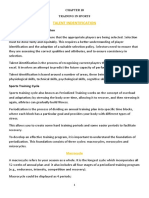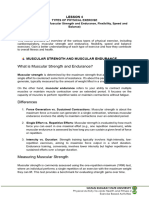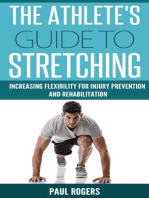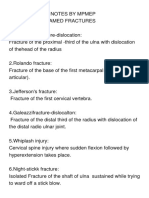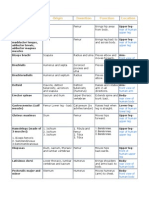0 ratings0% found this document useful (0 votes)
42 viewsDelerio, Janel O. Resistance Training Activity
Delerio, Janel O. Resistance Training Activity
Uploaded by
CatPlyometric training is the most effective approach for developing hypertrophy and strength according to the document. Plyometrics involves an eccentric contraction storing energy followed immediately by a concentric contraction, utilizing the stored energy to increase force. This stretch-shortening cycle underlies plyometrics' effectiveness. As a volleyball libero, the author would choose plyometrics to improve quick reactions and explosiveness through exercises like speed skater ladders and box jumps. Plyometrics training improves power and explosiveness essential for the libero position.
Copyright:
© All Rights Reserved
Delerio, Janel O. Resistance Training Activity
Delerio, Janel O. Resistance Training Activity
Uploaded by
Cat0 ratings0% found this document useful (0 votes)
42 views2 pagesPlyometric training is the most effective approach for developing hypertrophy and strength according to the document. Plyometrics involves an eccentric contraction storing energy followed immediately by a concentric contraction, utilizing the stored energy to increase force. This stretch-shortening cycle underlies plyometrics' effectiveness. As a volleyball libero, the author would choose plyometrics to improve quick reactions and explosiveness through exercises like speed skater ladders and box jumps. Plyometrics training improves power and explosiveness essential for the libero position.
Original Title
Resistance activity
Copyright
© © All Rights Reserved
Share this document
Did you find this document useful?
Is this content inappropriate?
Plyometric training is the most effective approach for developing hypertrophy and strength according to the document. Plyometrics involves an eccentric contraction storing energy followed immediately by a concentric contraction, utilizing the stored energy to increase force. This stretch-shortening cycle underlies plyometrics' effectiveness. As a volleyball libero, the author would choose plyometrics to improve quick reactions and explosiveness through exercises like speed skater ladders and box jumps. Plyometrics training improves power and explosiveness essential for the libero position.
Copyright:
© All Rights Reserved
0 ratings0% found this document useful (0 votes)
42 views2 pagesDelerio, Janel O. Resistance Training Activity
Delerio, Janel O. Resistance Training Activity
Uploaded by
CatPlyometric training is the most effective approach for developing hypertrophy and strength according to the document. Plyometrics involves an eccentric contraction storing energy followed immediately by a concentric contraction, utilizing the stored energy to increase force. This stretch-shortening cycle underlies plyometrics' effectiveness. As a volleyball libero, the author would choose plyometrics to improve quick reactions and explosiveness through exercises like speed skater ladders and box jumps. Plyometrics training improves power and explosiveness essential for the libero position.
Copyright:
© All Rights Reserved
You are on page 1of 2
Delerio, Janel O.
RESISTANCE TRAINING
ACTIVITY
1. Among the six resistance training systems from the lecture, Which has the most
effective approach in terms of developing muscular hypertrophy and strength? Briefly
discuss what happens physiologically. Kindly defend your answer by providing a reliable
source such as a journal, article, or study. (300 words).
A plyometric exercise comprises of three phases (1) Eccentric phase, or landing
phase, involves the pre-loading (energy is stored) of the agonist muscle group (2)
Amortization phase, or transition phase, is the time between the concentric and
eccentric phases. This time needs to be as short as possible otherwise the energy stored
during the eccentric phase dissipates, reducing the plyometric effect (3) Concentric
phase, or take-off phase, uses the stored energy to increase the force of the movement
The maximum force that a muscle will develop is attained throughout a rapid
eccentric contraction. However, it should be realized that muscles rarely perform one
type of contraction in isolation throughout athletic movements. when a concentric
contraction happens (muscle shortens) right away following an eccentric contraction
(muscle lengthens), then the force generated are often dramatically increased. This
stored energy is available to the muscle solely during a subsequent contraction. it is
essential to understand that this energy boost is lost if the eccentric contraction is not
followed instantly by a concentric contraction. to express this larger force, the muscle
must contract within the shortest time possible. This whole process is usually known as
the stretch-shortening cycle and is the underlying mechanism of plyometric training.
The squat is probably the foremost significant exercise for building strength,
power and muscle. whether you perform bodyweight squats to develop improved
endurance, jumping squats for more power, or weighted barbell squats for strength, all
of them offer you with an excellent workout and fitness gains. together with deadlifts,
bench press and rows / pull ups, it is one amongst the four most significant strength
training exercises. Squats work the largest muscles of the body, the glutes (Gluteus
Maximus) also called the buttocks. They also work the quads (Quadriceps) or outer thigh
and other muscles in the legs (hamstrings, calves), the spine and core, being particularly
good for strengthening the lower back. Sprinters, martial artists, swimmers, skiers and
dancers all have the benefit of the squat. In fact, each athlete will benefit from this
exercise.
2. Based on your own experience, what would you choose among the six training systems
to help your own muscles develop hypertrophy and strength? Why? Relate your answer
to your UAAP sport or recreational sport. Provide exercise examples specific to your
answer (300 words).
Plyometric training is a form of intense training that involves the use of a stretch
and contraction sequence of muscle fibers in order to generate great strength at a high
speed. With this type of training approach, it will improve the overall power and
explosiveness.
Plyometric exercises also involve a stretch of the muscles, immediately followed
by a contraction of the same muscles — that is why it’s typically cited as “jump
coaching.” While strength training principally creates nervous system and muscular
adaptations to get stronger, plyometric exercises can help improve explosiveness — a
person’s ability to generate maximum force in a very minimum time. Picture a sprinter
taking off at the starting line, or an Olympic long jumper jumping from stillness, they
both need explosive power to do what they do. Plyometrics is a very important
component of most professional sports performance training because it focuses on the
“speed” component of power.
As a libero it is very important to be quick on the floor. This training help me
improve my instincts during a game. To increase my reaction time, I exercise speed-
skater ladders. This fast footwork teaches the body to recruit bigger, stronger muscle
fibers to power your movement rather than relying on smaller muscle groups. Another
exercise is the forward two-foot box jumps. Box jumps will boost the heart rate, engage
an athlete’s quads and glutes, and reinforce the body’s ability to use major muscles
even when moving at high speeds.
You might also like
- Shock Method For Power Training - VerkhoshanskDocument14 pagesShock Method For Power Training - Verkhoshanskdiskra100% (2)
- Aerial ManualDocument27 pagesAerial ManualValegria Alarcón100% (4)
- Maxick - Muscle ControlDocument179 pagesMaxick - Muscle ControlGareth Griffiths100% (6)
- TMSTR Schexnayder Plyometric TrainingDocument4 pagesTMSTR Schexnayder Plyometric Trainingmarin0410100% (1)
- Taiji PlyometricsDocument3 pagesTaiji PlyometricsBoz OdusanyaNo ratings yet
- Musculoskeletal FitnessDocument3 pagesMusculoskeletal FitnessBengie mendizabalNo ratings yet
- Plyometrics for Athletes at All Levels: A Training Guide for Explosive Speed and PowerFrom EverandPlyometrics for Athletes at All Levels: A Training Guide for Explosive Speed and PowerRating: 5 out of 5 stars5/5 (1)
- Anatomy of Strength and Conditioning: A Trainer's Guide to Building Strength and StaminaFrom EverandAnatomy of Strength and Conditioning: A Trainer's Guide to Building Strength and StaminaRating: 4.5 out of 5 stars4.5/5 (4)
- Dynamic Stretching: The Revolutionary New Warm-up Method to Improve Power, Performance and Range of MotionFrom EverandDynamic Stretching: The Revolutionary New Warm-up Method to Improve Power, Performance and Range of MotionRating: 5 out of 5 stars5/5 (2)
- Intrinsic Back Muscles - DeepDocument3 pagesIntrinsic Back Muscles - DeepmkklmlkNo ratings yet
- Introduction To Plyometrics - Converting Strength To PowerDocument4 pagesIntroduction To Plyometrics - Converting Strength To Powerapi-286237903100% (1)
- Resistance Training (Weight Training)Document3 pagesResistance Training (Weight Training)Kristylle RenzNo ratings yet
- Plyometric TrainingDocument88 pagesPlyometric Trainingnc8vtvk9ydNo ratings yet
- Plyometrics Training For SoccerDocument5 pagesPlyometrics Training For SoccerYousuf ModinhoNo ratings yet
- Group 6 Principles of Training and ExerciseDocument11 pagesGroup 6 Principles of Training and ExerciseJezzie Rey ZamoraNo ratings yet
- Building StrengthDocument4 pagesBuilding Strengthmary.burnhamNo ratings yet
- Konsep PliometrikDocument14 pagesKonsep PliometrikM Farid ArafiNo ratings yet
- Wikipedia (2013) Strength TrainingDocument15 pagesWikipedia (2013) Strength TrainingGustavo AyalaNo ratings yet
- Xlathlete Triphasic Training High School Strength Training Manual 2.0Document154 pagesXlathlete Triphasic Training High School Strength Training Manual 2.0Luis AlfNo ratings yet
- 26 - Plyometric Training and DrillsDocument25 pages26 - Plyometric Training and DrillsCarlos GarciaNo ratings yet
- Plyometric Method: Vocational Sports Coaching UnesaDocument9 pagesPlyometric Method: Vocational Sports Coaching UnesaRembrant AnanthaNo ratings yet
- Enhancing Performance With Super StiffnessDocument4 pagesEnhancing Performance With Super Stiffnessval_ohalloran100% (1)
- Konsep PliometrikDocument14 pagesKonsep PliometrikM Farid ArafiNo ratings yet
- Thesis (5th Dan) - MR FitzgibbonDocument27 pagesThesis (5th Dan) - MR FitzgibbonBobby KhalsaNo ratings yet
- Strength Training For The MMA FighterDocument4 pagesStrength Training For The MMA Fightergearhead8No ratings yet
- Strong As An Ox Olympic Weightlifting Program Manual PDFDocument32 pagesStrong As An Ox Olympic Weightlifting Program Manual PDFJonathan Schroeder80% (5)
- Chapter 1: Basic Principles of Resistance Training andDocument12 pagesChapter 1: Basic Principles of Resistance Training andLuis Eduardo Barbosa Ortega100% (1)
- The Stretch-Shortening Cycle and Plyometric TrainingDocument5 pagesThe Stretch-Shortening Cycle and Plyometric TrainingMarcos GarciaNo ratings yet
- 10Document25 pages10Sarthak GuptaNo ratings yet
- Fundamentals of Plyometric Training A Guide For Fitness ProfessionalsDocument14 pagesFundamentals of Plyometric Training A Guide For Fitness ProfessionalsKyle ThomasNo ratings yet
- Elements of Fitness: Siff and Verkhoshansky (2009)Document8 pagesElements of Fitness: Siff and Verkhoshansky (2009)P NocuNo ratings yet
- Integrating Ballistic TrainingDocument4 pagesIntegrating Ballistic Trainingalex.narnleitnerNo ratings yet
- Unit Four Health Related Components of Fitness and Principles of Exercise PrescriptionDocument12 pagesUnit Four Health Related Components of Fitness and Principles of Exercise PrescriptionYoseph DefaruNo ratings yet
- TK - V2Document80 pagesTK - V2Lucía IcasattiNo ratings yet
- 02667-1c3a-3cf-Ff2-D5ee047b573f Short and Sweet Guide To Getting Stronger BiggerDocument29 pages02667-1c3a-3cf-Ff2-D5ee047b573f Short and Sweet Guide To Getting Stronger BiggerchakibaissatiNo ratings yet
- 10 TRAINING IN SPORTS-1hsuusDocument14 pages10 TRAINING IN SPORTS-1hsuusYashNo ratings yet
- PPintro Speed PowerDocument10 pagesPPintro Speed PowerWole Olaluwoye100% (1)
- Plyometrics Training For Soccer PDF FreeDocument5 pagesPlyometrics Training For Soccer PDF FreeGiuseppe Waitforit CapizziNo ratings yet
- Should We Program Heavy Strength Training For SprintersDocument7 pagesShould We Program Heavy Strength Training For SprintersAres Santiago R. NoguedaNo ratings yet
- 8099 18501 1 SMDocument6 pages8099 18501 1 SMJohannes PasaribuNo ratings yet
- Isometric Training: Holds, Presses and MoreDocument5 pagesIsometric Training: Holds, Presses and Morecynneath6252No ratings yet
- Circuit Training 1Document10 pagesCircuit Training 1FULCRUMNo ratings yet
- Components of Training - IDocument17 pagesComponents of Training - IYouTube MirchiNo ratings yet
- Plyometrics: Academic In-Charge, Department of Physiotherapy, NIMSDocument5 pagesPlyometrics: Academic In-Charge, Department of Physiotherapy, NIMSJayanth KBNo ratings yet
- Basics of Plyometrics and Program DesigningDocument10 pagesBasics of Plyometrics and Program DesigningBhavesh HotwaniNo ratings yet
- Strengthtraining 1Document26 pagesStrengthtraining 1craig1014100% (5)
- Cross Fit MetodologiaDocument4 pagesCross Fit Metodologiabacharelado2010No ratings yet
- Module 3 - PlyometricsDocument14 pagesModule 3 - PlyometricsAllen John Malig-onNo ratings yet
- Pathfit ReportDocument12 pagesPathfit Reportjoeysolis07No ratings yet
- Module 2 NotesDocument13 pagesModule 2 NotesAngelo GudesNo ratings yet
- Physical Fitness Notes Second AssessmentDocument116 pagesPhysical Fitness Notes Second AssessmentElena JordanovaNo ratings yet
- Types of ExercisesDocument10 pagesTypes of ExercisesfharnizaparasanNo ratings yet
- 525 Study GuideDocument4 pages525 Study GuideIranj JalapangNo ratings yet
- Functional Training for Athletes at All Levels: Workouts for Agility, Speed and PowerFrom EverandFunctional Training for Athletes at All Levels: Workouts for Agility, Speed and PowerRating: 4 out of 5 stars4/5 (2)
- SquatStrong: A Revolutionary 6 Week Program to New Prs and Higher PerformanceFrom EverandSquatStrong: A Revolutionary 6 Week Program to New Prs and Higher PerformanceRating: 3 out of 5 stars3/5 (4)
- Exo-Kinetics: A Guide to Explosive Performance and TrainingFrom EverandExo-Kinetics: A Guide to Explosive Performance and TrainingRating: 3 out of 5 stars3/5 (1)
- The Runner's Expert Guide to Stretching: Prevent Injury, Build Strength and Enhance PerformanceFrom EverandThe Runner's Expert Guide to Stretching: Prevent Injury, Build Strength and Enhance PerformanceRating: 4 out of 5 stars4/5 (1)
- The Athlete's Guide to Stretching: Increasing Flexibility For Inury Prevention And RehabilitationFrom EverandThe Athlete's Guide to Stretching: Increasing Flexibility For Inury Prevention And RehabilitationRating: 4 out of 5 stars4/5 (1)
- I Na's C Upcakes I Na's C Upcakes I Na's C UpcakesDocument1 pageI Na's C Upcakes I Na's C Upcakes I Na's C UpcakesCatNo ratings yet
- Task 3 CoachingDocument1 pageTask 3 CoachingCatNo ratings yet
- Project Proposal: State Your Primary Reasons of Organizing This ActivityDocument6 pagesProject Proposal: State Your Primary Reasons of Organizing This ActivityCatNo ratings yet
- Pedigree Analysis Hand-OutDocument4 pagesPedigree Analysis Hand-OutCatNo ratings yet
- Badminton Lesson PlanDocument8 pagesBadminton Lesson PlanCatNo ratings yet
- Project Proposal: State Your Primary Reasons of Organizing This ActivityDocument7 pagesProject Proposal: State Your Primary Reasons of Organizing This ActivityCatNo ratings yet
- ExercisesDocument3 pagesExercisesCatNo ratings yet
- Must To Know Formulas (NMAT)Document2 pagesMust To Know Formulas (NMAT)CatNo ratings yet
- Certificate For Catrina Dimayacyac For "Evaluation For KKK-COVID19 Mahirap Maging Mahirap - How Are The Poor Coping With COVID-19?"Document1 pageCertificate For Catrina Dimayacyac For "Evaluation For KKK-COVID19 Mahirap Maging Mahirap - How Are The Poor Coping With COVID-19?"CatNo ratings yet
- Pedagology ApproachesDocument1 pagePedagology ApproachesCatNo ratings yet
- Topics For Reporting and ReportersDocument1 pageTopics For Reporting and ReportersCatNo ratings yet
- August 6 September 30docxDocument2 pagesAugust 6 September 30docxCatNo ratings yet
- Statistical Assistance Certification Form: This Is To Certify That The Statistical Data For This Manuscript EntitledDocument1 pageStatistical Assistance Certification Form: This Is To Certify That The Statistical Data For This Manuscript EntitledCatNo ratings yet
- SPC Crude Drugs CarbohydratesDocument3 pagesSPC Crude Drugs CarbohydratesCatNo ratings yet
- Cvs (Diuretics)Document2 pagesCvs (Diuretics)CatNo ratings yet
- Bay Leaves Group 2 Plant Material Data SheetDocument7 pagesBay Leaves Group 2 Plant Material Data SheetCat100% (1)
- Experiment 4 RecrystallizationDocument17 pagesExperiment 4 RecrystallizationCatNo ratings yet
- Tablets: Tablets Characteristics of Ideal TabletDocument4 pagesTablets: Tablets Characteristics of Ideal TabletCatNo ratings yet
- Ankle Sprain CaseDocument11 pagesAnkle Sprain CaseFLORENZ PAGNANAWONNo ratings yet
- Character Rigging Animation Guide Explanimated PDFDocument5 pagesCharacter Rigging Animation Guide Explanimated PDFKingston SukamtoNo ratings yet
- CT and MR Imaging Ofthe HipDocument11 pagesCT and MR Imaging Ofthe HipsaadNo ratings yet
- Female PelvisDocument23 pagesFemale Pelvisvarsha yamgar0% (1)
- DPC Cristiane CarboniDocument51 pagesDPC Cristiane CarboniLuis Salazar AscencioNo ratings yet
- All Types of #SDocument6 pagesAll Types of #SEashwar Prasad MeenakshiNo ratings yet
- Muscle Chart Body MapDocument4 pagesMuscle Chart Body MapmaspogiakosayoNo ratings yet
- 02A Lesson Proper For Week 1: Physical Education 1Document17 pages02A Lesson Proper For Week 1: Physical Education 11102F- Domasig, Rochelle P.No ratings yet
- Nursing-AnaPhy-Muscular System Upper BodyDocument21 pagesNursing-AnaPhy-Muscular System Upper BodyGail Chantel Spring PerlasNo ratings yet
- (Template) EXERCISE 6 - SKELETAL SYSTEMDocument4 pages(Template) EXERCISE 6 - SKELETAL SYSTEMBai Putri Rohaina S. MalangNo ratings yet
- Muscle Intelligence 30-Day Primer - ArmsDocument29 pagesMuscle Intelligence 30-Day Primer - ArmsPK100% (1)
- Review of The Biomechanical Function of The Elbow Joint During Tennis StrokesDocument11 pagesReview of The Biomechanical Function of The Elbow Joint During Tennis StrokesAdrian GonzalesNo ratings yet
- Arthroscopic Wrist AnatomyDocument8 pagesArthroscopic Wrist AnatomyLaineyNo ratings yet
- Yoga Exercises With IllustrationsDocument7 pagesYoga Exercises With IllustrationsAndromeda StanNo ratings yet
- Physical Examination of The Knee: Oleh: Dr. Feby Deliana Pembimbing: Dr. Deta Tanuwidjadja.,SpkfrDocument25 pagesPhysical Examination of The Knee: Oleh: Dr. Feby Deliana Pembimbing: Dr. Deta Tanuwidjadja.,Spkfrsingle_ladyNo ratings yet
- SGVP Holistic H-Wps OfficeDocument11 pagesSGVP Holistic H-Wps OfficeHpNo ratings yet
- Stretch Guide'Document57 pagesStretch Guide'samyak jainNo ratings yet
- Ramplissage Ram ChidambaramDocument6 pagesRamplissage Ram ChidambaramProsenjit BhowalNo ratings yet
- The Hip Joint Anatomy: DR Shaifaly Madan RustagiDocument23 pagesThe Hip Joint Anatomy: DR Shaifaly Madan RustagiateoNo ratings yet
- Vanguard System SummaryDocument6 pagesVanguard System SummaryBobNo ratings yet
- Module 2Document53 pagesModule 2matt100% (1)
- Aneurysmal Bone Cyst: Review ArticleDocument9 pagesAneurysmal Bone Cyst: Review ArticleJeyachandran MariappanNo ratings yet
- Dosen Pengampu Mata Kuliah Fisiotherapy: Dr. Konni Kurniasih, M.Kes., AIFODocument7 pagesDosen Pengampu Mata Kuliah Fisiotherapy: Dr. Konni Kurniasih, M.Kes., AIFOilham POYNo ratings yet
- 25 Lessons From Eshkok Wachman Movement Notation-CopiarDocument140 pages25 Lessons From Eshkok Wachman Movement Notation-CopiarGuillermo Gerardo Gaxiola Cerecer100% (1)
- ARNOLDDocument8 pagesARNOLDMouhamed HamoudiNo ratings yet
- Specialized Chest Hypertrophy Workout Lagging Body PartsDocument14 pagesSpecialized Chest Hypertrophy Workout Lagging Body PartsShabeer DarNo ratings yet
- Final Annotated Bib - Unhappy TriadDocument21 pagesFinal Annotated Bib - Unhappy Triadapi-458073428No ratings yet
- Biomechanics of Knee Joint - 20 Questions-2Document5 pagesBiomechanics of Knee Joint - 20 Questions-2rehab aymanNo ratings yet
























